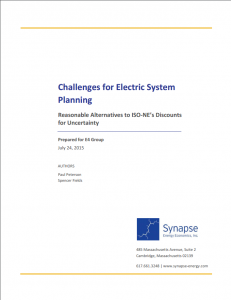Full Title: Challenges for Electric System Planning
Author(s): Paul Peterson and Spencer Fields
Publisher(s): Synapse Energy Economics,
Publication Date: July 1, 2015
Full Text: Download Resource
Description (excerpt):
From 2002 through June 2015 New England ratepayers spent approximately $7.5 billion on transmission additions and expansions. The most recent Regional System Plan Project List identifies planned additions of 210 projects with an estimated cost of $4.8 billion over the next 10 years in order to maintain continued reliable and economic operation of the system.1 The Regional System Planning Process at ISO New England (ISO‐NE) evaluates reliability needs for the region based upon a needs assessment planning process. The needs assessment is based upon various planning assumptions including load levels, generation dispatch scenarios, inter‐region transfer limits, and the retirement or development of generation resources. This report focuses on the specific issue of ISO‐NE’s assumptions relating to the forecasting of solar photovoltaic (PV) and energy efficiency and their effect on load forecasts. The regional long‐term load forecast is a critical element in determining transmission expansion. The system is evaluated against this forecast in order to determine where and when transmission upgrades may be required to ensure reliability. ISO‐NE applies numerous discounts to both its energy efficiency and distributed generation forecasts to address perceived uncertainties about future state policies, tax credits and other incentives, electricity costs, and alternative resource costs. While the forecast of the regional net peak and annual energy reflects the additions of PV and energy efficiency, the uncertainty assumptions result in PV and energy efficiency forecasts that substantially understate the impact of these resources. Even when industry trends and ISO‐NE data show that the steep discounts are not warranted, the ISO continues to apply them. This leads to forecasts that overstate future electric system loads. As a result, ratepayers are being asked to pay for more transmission upgrades than are needed.
This paper highlights significant discrepancies between current data and trends regarding contributions of energy efficiency and PV resources to reductions in load and ISO‐NE’s forecasts regarding the future contributions of these resources. Based upon analysis of actual trends in implementation of energy efficiency and PV shown by the data, the paper provides a basis for more accurate and reliable forecasts. The purpose of the paper is to highlight the impact of overly conservative “uncertainty” assumptions on system planning and provide ISO‐ NE and stakeholders a basis for further discussion.
